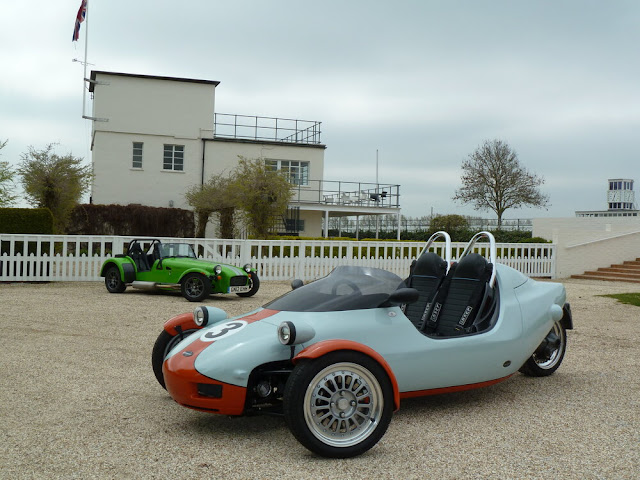Three wheeled cars have always fascinated your author and the most compelling of these put two wheels in front. The inherent stability and performance potential of this layout is hard to ignore and the Grinnall Scorpion is a perfect example of it. As a track day car or fair weather toy, it excels. It was also exciting from a design standpoint, with a "form follows function" approach and clean, timeless lines.
Grinnall Specialist Cars was founded by Mark Grinnall in Bewdley, Worcestershire, UK in the 1980's. While they got their start doing hot-rod Triumph TR7 conversions, their place in the history of specialty cars was cemented by the Scorpion 3. In search of a radical but affordable high-performance vehicle, Mark Grinnall combined his passion for motorcycling and his skills as an engineer to produce an innovative three-wheeler, which would be high-tech, mid-engine and rear wheel driven. Designer Steve Harper penned the Scorpion's iconic exterior design.
The Scorpion 3 made its debut in 1992 when it was featured in a CAR magazine article written by a young Colin Goodwin. Interest in the car exploded in the mid 90’s, being featured in dozens of magazines worldwide.
 |
| The Grinnall Scorpion 3 Chassis, at rear |
The core of the Scorpion is a box-section, tubular spaceframe chassis, upon which a GRP body tub is mounted and bonded. In front, a racecar inspired inboard spring and wishbone suspension is employed while a modified version of its motorcycle donor's hardware is used at the rear. The car's low center of gravity and relatively exotic configuration made for tremendous handling.
Motivation comes from BMW K-Series motorcycle engines, in either 750 cc 3-cylinder or a 1200 cc, 4-cylinder, giving power outputs from 75 bhp (56 kW) to 130 bhp (97 kW). This might not sound like much on paper, but the car's power to weight ratio helped make the most of those horses. The whole package weighs less than 1,000lbs in either guise.
The K-Series sequentially shifted 5-speed transmission is retained and actuated from a stick shift in the cockpit. The BMW driveshaft is retained running through a modified hub with an automotive tire at the rear. The rear wheel is of a smaller circumference than the bike's wheel so the gearing is optimized for a lower top speed of around 125 mph (201 km/h) with 0-60 mph (97 km/h) taking around 6 seconds when using a K1100 engine.
 |
| The Grinnall Scorpion 3 interior |
The close quartered, compact interior accommodates two seats with 4-point harnesses. No nonsense controls are laid out across a spartan dash board with a concise gauge binnacle. Twin roll hoops protrude from the bodywork behind the cockpit for additional protection in the unlikely event of a rollover. No provisions for a roof are made, but optional windscreens offer some degree of protection from the elements, as well bugs. This is decidedly not a car for inclement weather.
The Scorpion was offered in both factory built and component forms and is still being produced today. A four wheeled variant was also made and imaginatively named the Scorpion 4. In recent years Grinnall has expanded into the traditional "Trike" motorcycle market offering conversions for makes such as Triumph, BMW, and Indian.
 |
| The Grinnall Scorpion 3 at rear |
 |
| The Grinnall Scorpion 3 in profile |
 |
| The Grinnall Scorpion 3, front 3/4 view |
 |
| The Grinnall Scorpion 3, head on |
 |
| The Grinnall Scorpion 3, front right |
 |
| The Grinnall Scorpion 3 profile |
 |
| The Grinnall Scorpion 3, front right |
 |
| The Grinnall Scorpion 3, near profile |
 |
| The Grinnall Scorpion 3, in red, front 3/4 view |
 |
| The Grinnall Scorpion 3, right rear view |
 |
| The Grinnall Scorpion 3, left rear |
 |
| The Grinnall Scorpion 3, at rear overhead |
 |
| The Grinnall Scorpion 3, underbelly |
 |
| The Grinnall Scorpion 3, rear chassis detail |
 |
| The Grinnall Scorpion 3, front chassis detail |
 |
| The Grinnall Scorpion 3, seating arrangement |
 |
| The Grinnall Scorpion 3 dashboard |
 |
| The Grinnall Scorpion 3 cockpit |
 |
| The Grinnall Scorpion 3 trunk lid removed |


























Comments
Post a Comment